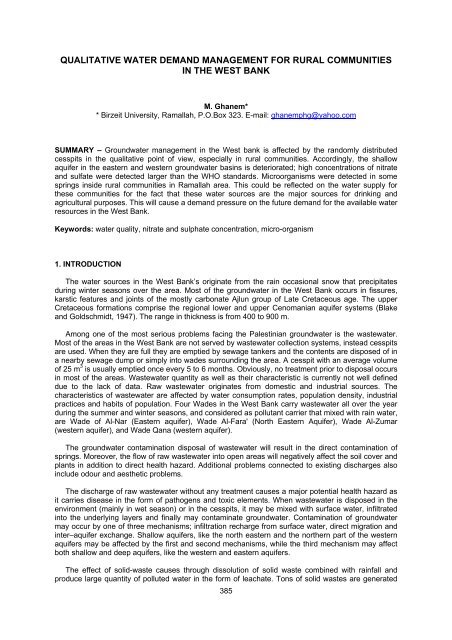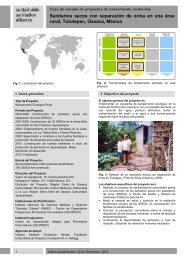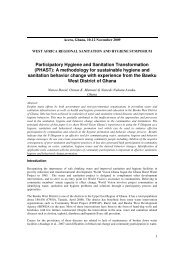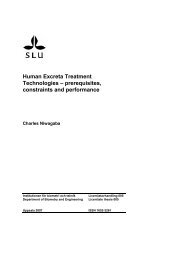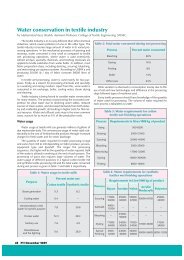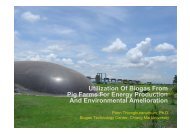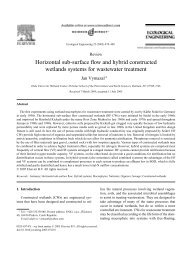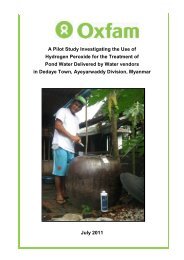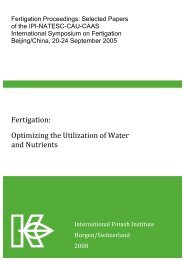qualitative water demand management for rural ... - SSWM
qualitative water demand management for rural ... - SSWM
qualitative water demand management for rural ... - SSWM
Create successful ePaper yourself
Turn your PDF publications into a flip-book with our unique Google optimized e-Paper software.
QUALITATIVE WATER DEMAND MANAGEMENT FOR RURAL COMMUNITIES<br />
IN THE WEST BANK<br />
M. Ghanem*<br />
* Birzeit University, Ramallah, P.O.Box 323. E-mail: ghanemphg@yahoo.com<br />
SUMMARY – Ground<strong>water</strong> <strong>management</strong> in the West bank is affected by the randomly distributed<br />
cesspits in the <strong>qualitative</strong> point of view, especially in <strong>rural</strong> communities. Accordingly, the shallow<br />
aquifer in the eastern and western ground<strong>water</strong> basins is deteriorated; high concentrations of nitrate<br />
and sulfate were detected larger than the WHO standards. Microorganisms were detected in some<br />
springs inside <strong>rural</strong> communities in Ramallah area. This could be reflected on the <strong>water</strong> supply <strong>for</strong><br />
these communities <strong>for</strong> the fact that these <strong>water</strong> sources are the major sources <strong>for</strong> drinking and<br />
agricultural purposes. This will cause a <strong>demand</strong> pressure on the future <strong>demand</strong> <strong>for</strong> the available <strong>water</strong><br />
resources in the West Bank.<br />
Keywords: <strong>water</strong> quality, nitrate and sulphate concentration, micro-organism<br />
1. INTRODUCTION<br />
The <strong>water</strong> sources in the West Bank’s originate from the rain occasional snow that precipitates<br />
during winter seasons over the area. Most of the ground<strong>water</strong> in the West Bank occurs in fissures,<br />
karstic features and joints of the mostly carbonate Ajlun group of Late Cretaceous age. The upper<br />
Cretaceous <strong>for</strong>mations comprise the regional lower and upper Cenomanian aquifer systems (Blake<br />
and Goldschmidt, 1947). The range in thickness is from 400 to 900 m.<br />
Among one of the most serious problems facing the Palestinian ground<strong>water</strong> is the waste<strong>water</strong>.<br />
Most of the areas in the West Bank are not served by waste<strong>water</strong> collection systems, instead cesspits<br />
are used. When they are full they are emptied by sewage tankers and the contents are disposed of in<br />
a nearby sewage dump or simply into wades surrounding the area. A cesspit with an average volume<br />
of 25 m 3 is usually emptied once every 5 to 6 months. Obviously, no treatment prior to disposal occurs<br />
in most of the areas. Waste<strong>water</strong> quantity as well as their characteristic is currently not well defined<br />
due to the lack of data. Raw waste<strong>water</strong> originates from domestic and industrial sources. The<br />
characteristics of waste<strong>water</strong> are affected by <strong>water</strong> consumption rates, population density, industrial<br />
practices and habits of population. Four Wades in the West Bank carry waste<strong>water</strong> all over the year<br />
during the summer and winter seasons, and considered as pollutant carrier that mixed with rain <strong>water</strong>,<br />
are Wade of Al-Nar (Eastern aquifer), Wade Al-Fara' (North Eastern Aquifer), Wade Al-Zumar<br />
(western aquifer), and Wade Qana (western aquifer).<br />
The ground<strong>water</strong> contamination disposal of waste<strong>water</strong> will result in the direct contamination of<br />
springs. Moreover, the flow of raw waste<strong>water</strong> into open areas will negatively affect the soil cover and<br />
plants in addition to direct health hazard. Additional problems connected to existing discharges also<br />
include odour and aesthetic problems.<br />
The discharge of raw waste<strong>water</strong> without any treatment causes a major potential health hazard as<br />
it carries disease in the <strong>for</strong>m of pathogens and toxic elements. When waste<strong>water</strong> is disposed in the<br />
environment (mainly in wet season) or in the cesspits, it may be mixed with surface <strong>water</strong>, infiltrated<br />
into the underlying layers and finally may contaminate ground<strong>water</strong>. Contamination of ground<strong>water</strong><br />
may occur by one of three mechanisms; infiltration recharge from surface <strong>water</strong>, direct migration and<br />
inter–aquifer exchange. Shallow aquifers, like the north eastern and the northern part of the western<br />
aquifers may be affected by the first and second mechanisms, while the third mechanism may affect<br />
both shallow and deep aquifers, like the western and eastern aquifers.<br />
The effect of solid-waste causes through dissolution of solid waste combined with rainfall and<br />
produce large quantity of polluted <strong>water</strong> in the <strong>for</strong>m of leachate. Tons of solid wastes are generated<br />
385
daily in West Bank and most of it ends up in open dumpsites. Solid waste problem in West Bank is<br />
especially grave as a result of three main reasons; population growth rate, rising of living and<br />
consumption patterns. This situation results in an increase in the number of dumpsites to reach<br />
around 89 dumpsites (Al-Hamaidi, 1993). Because of heterogeneous nature of wastes and variations<br />
in aquifer properties, landfill sites represent a challenging opportunity to try and understand the<br />
transport and fate of waste-derived contaminants (Abu-Rukah & Al-Kofahi, 2001).<br />
The major heavy metals found in leachate included Pb, Fe, Mn, Cd , Ni and Zn while the organic<br />
compound were aromatic hydrocarbons (mainly xylenes), phenols and pesticides (kjeldsen,1992).<br />
Toxic materials and pathogenic organisms may end in ground or surface <strong>water</strong> as a result of the<br />
movement of leachate from landfills.<br />
2. PROBLEM DEFINITION<br />
The effect of hydrochemical changes of the <strong>water</strong> quality allocation sources in the West Bank<br />
should put threats to the ground<strong>water</strong> as well as surface <strong>water</strong> sources against natural and man made<br />
pollution. The <strong>qualitative</strong> changes will help to address the hydrochemical changes in order to build a<br />
related decision support system. These <strong>qualitative</strong> analyses should have the benefit <strong>for</strong> the<br />
maximized hygienic <strong>water</strong> <strong>for</strong> the people both quantitatively and <strong>qualitative</strong>ly manners and preserving<br />
the ecosystem in the area. The present study aims to assess the negative impacts of pollutants of<br />
solid waste dumpsites and the liquid wastes in some selected areas on the quality of ground<strong>water</strong>,<br />
especially the springs. This is accomplished by selecting several wells around the dumpsites and<br />
waste<strong>water</strong> wade discharge and testing their physical, chemical and biological characteristics. This<br />
study is important to reduce environmental pollutant discharge as well as to improve <strong>water</strong> quality and<br />
resources sustainability.<br />
3. BACKGROUND ABOUT THE STUDY AREA<br />
A series of aquifers and aquicludes in the West Bank are as follows: Kurnub (Kurnov) group<br />
aquiclude, Ajlun series (Judean group) aquifer, Belqa series (Mount Scoupes group) aquiclude, Jenin<br />
sub-series aquifer to aquitard and Beide and Lisan aquifer. The aquifer system in the West Bank is<br />
heterogeneous and its parameters are varying from point to point (Tahal, 1966). The aquifer system<br />
includes one upper phreatic and two lower confined aquifer systems. Ground<strong>water</strong> is found in<br />
<strong>for</strong>mations of Pleistocene to lower Cenomanian age, at depth ranging from several hundred of meters<br />
to many meters. In the area under investigation, five sub-aquifers are located within unconfined and<br />
confined strata. These aquifers are the unconfined Pleistocene, Neogene and Eocene and the<br />
confined upper and lower Cenomanian sub-aquifers. Two main structural folds are dominant in the<br />
study area, the Anabta anticline and Nablus-Beit Qad syncline. Most of the faults trend east west with<br />
some faults trending northwest southeast. Joints and karstic caves are well developed in the<br />
Bethlehem, Hebron and Jerusalem <strong>for</strong>mations.<br />
The West Bank aquifers, especially the western is considered to be sensitive from the hydrological<br />
point of view. This originates from the direct recharge of the rainfall to the ground<strong>water</strong>. The<br />
outcroppings rocks are of sedimentary rocks and composed of limestone, dolomite as well as thin<br />
laminations of marl and chalky limestone. The whole area is semi karstified and of direct effluent to<br />
the ground<strong>water</strong> bellow. The infiltration rate is higher than other areas in the West Bank and reaches<br />
in some places 26% of the rainfall.<br />
The natural outlet of the ground<strong>water</strong> in the West Bank is the springs that are spread inside the<br />
villages and the surroundings. More than 300 springs are recognized in the West Bank. The majority<br />
of these springs are suffering from the leakage of the cesspits, which are spreading in the whole area<br />
considering the major sewage system there in the absence of systematic sewage system with<br />
treatment facilities. Those springs are polluted to some extent from these cesspits in the area. This<br />
pollution is considered to be dangerous from the health point of view, in the reason that these springs<br />
are used <strong>for</strong> drinking and agricultural purposes. Water Pollution cause diseases <strong>for</strong> the inhabitants in<br />
the area.<br />
386
4. METODOLOGY<br />
Field work and <strong>water</strong> sampling campaign was done during the last five years through different<br />
Palestinian institutions, among these are the Palestinian Water Authority, Universities and the<br />
Palestinian Hydrology Group in order to have imprints about the ground<strong>water</strong> quality changes.<br />
Historical data from different governmental and none governmental sources are available in the<br />
period of twenty years.<br />
The physical parameters such as temperature, pH, electrical conductivity (EC), total hardness<br />
(TH), and total dissolved solids (TDS) were measured, while the chemical parameters contain major<br />
cations (Ca2+, Mg2+, K+, Na+), major anions (HCO3-, NO3-, Cl-, SO42-), major ions (PO43-) and<br />
heavy metals (Pb, Fe, Mn, Cd, Zn, Al, Ba,….) were analysed. In some samples BOD, COD, TSS and<br />
Total and Fecal coli<strong>for</strong>ms are analysed.<br />
5. DISCUSSION AND RESULTS<br />
The Human activities cause pollution to the ground<strong>water</strong> through the followings: Discharge of<br />
inadequately treated effluent municipal treatment plants, Discharge of untreated domestic and<br />
agricultural wastes, Discharge of untreated domestic and agricultural wastes, Extraction, use, and<br />
disposal of poor - quality ground <strong>water</strong>, Leach ate from solid waste landfills, Runoff from urban<br />
drainage, Fertilizer and pesticide residues and Drainage of wetlands. Due to the uncontrolled waste<br />
disposal patterns in the West Bank as a whole, some levels of the contaminants were found in<br />
ground<strong>water</strong>. The level of trace metals in ground<strong>water</strong> depends on the ion exchange capacity of the<br />
soil layer that will attenuate the down gradient movement. But the level of organic matter in<br />
ground<strong>water</strong> depends on the organic content of the soil and biodegradation rate. Natural filtration<br />
through geological <strong>for</strong>mations will affect the presence of trace metals, organic matter and the physical<br />
parameters such as TDS, EC, pH, temperature and total hardness.<br />
In Nablus city it self, the network covers 70% of households. The remaining part of the population<br />
uses cesspits. The western sewerage pipeline, within the municipal boundaries, discharges into Wadi<br />
Nablus, as does the waste<strong>water</strong> from several villages located close to Nablus. The present pipeline<br />
discharges into Wadi Al-Sajoor, from where sewage flows through Wadi El Badan and into the Jordan<br />
valley. In this way, waste<strong>water</strong> either pollutes the aquifer through percolation or is used by farmers <strong>for</strong><br />
irrigation. Waste<strong>water</strong> in Tulkarm district is either collected and discharges into Wades or temporarily<br />
stored in cesspits prior to dumping (ARIJ, 2002). A survey carried out by ARIJ in 1996 showed that<br />
70% of the population depends on cesspits <strong>for</strong> waste<strong>water</strong> disposal and only 30% benefit from<br />
connection to a sewerage system, and that these only exist within the borders of Tulkarem<br />
municipalities and refugee camps. Only 50% of the waste<strong>water</strong> in Qalqilia flows into the stabilization<br />
ponds operated by the municipalities; the other half flows western. The leakage of waste<strong>water</strong> from<br />
the sewerage networks in both Tulkarem and Qalqilia reaches 50% (Arij, 2002).<br />
6. EFFECT OF PESTICIDES AND FERTILIZERS<br />
Pesticides are applied rather generously in the West Bank; <strong>for</strong> example, 15,000 metric tons are<br />
applied every year in Israel and the West Bank. Pesticides are also transported by runoff affecting<br />
aquatic ecosystems. The total quantity of pesticide used is estimated at 730 tons in the West Bank<br />
(ARIJ, 2003). In the West Bank, the pesticides are used intensively in the irrigated agricultural areas,<br />
<strong>for</strong> example in the Jordan valley, north of the West Bank and Gaza Strip. The agricultural sector uses<br />
of pesticide have increased by using green house in which they use 372 tones per year from the<br />
disinfecting gas like Methyl Bromide. It is important to emphasize that this is halide organic compound<br />
and widely used.<br />
Fertilizers are applied in large quantities in the West Bank, often in the irrigation <strong>water</strong>. Fertilizers<br />
reach aquatic ecosystems, where they can cause eutrophication, and they also contaminate ground<br />
<strong>water</strong>. Thus, <strong>water</strong> drawn from Wades and aquifers <strong>for</strong> agriculture contaminates and alters ecosystem<br />
functioning. Again, such indirect effects of <strong>water</strong> use may be environmentally more significant than<br />
their direct effects.<br />
387
7. VOLATILE AND SEMIVOLATILE ORGANIC COMPOUNDS IN NATOV CATCHMET<br />
Some springs in the Natuf drainage area, which is located in the Western aquifer and to the west<br />
of Ramallah city in the West Bank in Palestine, has been found to contain traces of Volatile Organic<br />
Compounds (VOC), and larger amounts of Semi-Volatile Organic Compounds (SVOC). Since VOC<br />
are easily removed by good aeration and the concentrations of VOC found from the analysis of<br />
spring's <strong>water</strong> were less than 2 mg/L, which proves that these springs are located in shallow perched<br />
aquifers and are well aerated. SVOC concentrations in ground<strong>water</strong> depend on the compound type,<br />
site-specific geology, hydrology and anthropogenic factors. SVOC are originated mainly from<br />
excessive use of pesticides, herbicides and from petroleum products. They are hardly degradable<br />
species and can remain attached to soil particles <strong>for</strong> longer time, which means that their concentration<br />
is accumulative. The fact that many kinds of pesticides and herbicides are being used by farmers in<br />
the area <strong>for</strong> grapes, figs and even <strong>for</strong> olive fields. Such compounds are toxic to mankind, cattle and<br />
affects quality of ground<strong>water</strong> in the area. The variation of concentration of SVOC from one spring to<br />
another and from one year to another can be related to hydrological and anthropogenic factors only. It<br />
can be noticed that the concentration of Alkanes, Alkenes, Cycloalkanes and cycloalkenes has<br />
increased from 129ppm as an accumulative value in the year 1999 to a value of 316ppm in the year<br />
2000.<br />
8. HYDROCHEMICAL ASSESSMENT OF NATOV CATCHMENT SPRINGS<br />
The <strong>water</strong> spring samples of Ein El Maasal, Ein Qinia, Ein Harasha, Ein El Balad – Surda, Ein Arik,<br />
Ein Mutzbah, Ein Um Aisha and Ein Shik Yousef were analyzed hydrochemically in wet and dry<br />
seasons <strong>for</strong> the year 1999/2000. The analyzed spring reveals of Ca-HCO3 type, Ca-Mg-HCO3 type in<br />
wet and dry seasons, respectively. All of them reveal of no pollution. The trace elements of Si, Cd, Sr,<br />
B, Zn, Mo, P, Cu, Fe, Ni, Pb, Ag, V, Cr and Mn reveal that the springs are enriched with S and Si. The<br />
average of S and Si is 10 and 4 mg/L, respectively. Sulfer shows its maximum limit at the Ein<br />
Mutzbah (20 mg/L), while the silicon shows its maximum limit at Ein Massal. Ein Mutzbah shows a<br />
high concentration of NO3 and SO4 due to the nearby cesspits that are of direct affect to the spring.<br />
Two spring cases of a non-contaminated spring Ein Areek and a contaminated spring Ein Mutzbah<br />
were reported. The Hydrochemical parameters of Ca as well as Mg in Ein Misbah spring show an<br />
increasing trend, while the other parameters show a decreasing trend from the start of winter to its<br />
end.<br />
9. SPRING WATER QUALITY IN HEBRON<br />
Thirty <strong>water</strong> spring samples were analysed hydrochemically <strong>for</strong> the Beit Ula springs / western<br />
Hebron reveals that the two springs of Mohammad Yousef and Sharawi showed high concentration of<br />
Nitrates (62 mg/L). The EC of these two springs are 1077 and 1137 micro Semins/cm, respectively.<br />
The two springs showed also too numerous to be counted from total and fecal coli<strong>for</strong>ms. This is due<br />
to the infiltrated nearby cesspits to those springs in the area, the high pH (8.5) enrich this waste<strong>water</strong><br />
cesspits pollution results. Another two springs (Al Far and Fawzi Al Adam)showed a high<br />
concentration of chloride, 248 and 277 mg/L and sulphate (55 and 64 mg/L), respectively. This is due<br />
to the agricultural activities of the fertilizers that are used by the farmers in the agricultural fields<br />
nearby those springs.<br />
10. TREATED WASTEWATER ANALYSIS IN RAMALLAH<br />
Treated waste<strong>water</strong> samples in the year 2000 were analyzed <strong>for</strong> major ions from the waste<strong>water</strong><br />
flow outlet in Beitunia area near Ramallah. The waste<strong>water</strong> type reveals of Na-Cl type. The average<br />
of NO3 is found to be 64 mg/L, which is considered to be good treated waste<strong>water</strong> to be recharged<br />
within the catchment.<br />
388
11. WATER QUALITY IMPLICATIONS FOR WATER MANAGEMENT<br />
Concentrations of all major ions are below drinking <strong>water</strong> standards and the EC and pH values are<br />
indicative of generally good quality <strong>water</strong>. This is confirmed by the analytical results of trace elements<br />
and organic compounds. It should be noted that the most springs around Ramallah, sampled and<br />
analyzed during 1999 - 2004 were found to discharge pristine drinkable <strong>water</strong>. Two exceptions of the<br />
springs of Ein Mutzbah and Surda showed elevated NO3, attributed to the animal manure (sheep<br />
herds of local farmers) or human waste. In addition a gasoline by-product was detected in trace<br />
concentrations in most springs, suggesting rapid recharge of ground<strong>water</strong> by surface <strong>water</strong> flushing<br />
the roads. Higher nitrate concentrations were limited to the station draining the industrial area, but<br />
were below drinking <strong>water</strong> levels.<br />
Urban runoff pollution results from numerous sources including rainfall that becomes contaminated<br />
as it travels through the atmosphere, along the land surface, and makes its way to a <strong>water</strong> body.<br />
Since urban runoff, which enters <strong>water</strong> bodies from diffuse or unidentifiable locations and sources,<br />
can cause significant <strong>water</strong> quality degradation, it certainly should be addressed as part of a<br />
municipality’s overall urban runoff pollution prevention and control program that present unique<br />
challenges. Land development and intensive land use lead directly to many of the pollution problems<br />
associated with urban runoff. These problems can be divided into two basic categories: hydrologic<br />
impact of urbanization and urban runoff pollution.<br />
Realizing that the western Catchments strongly control the <strong>water</strong> quality of their draining rivers,<br />
recent discussions on new <strong>water</strong> quality measures include the characteristics of the contributing<br />
Catchments. Industrial, urban and agricultural pollution has led to the accumulation of contaminants in<br />
sediments, plants, and ground<strong>water</strong> reservoirs. In general short residence times in karstified aquifers<br />
result in a limited ability of self-purification. The aquifer below Ramallah is composed of karstified<br />
limestone and dolomite, and as such is highly vulnerable to contaminant migration from land surface<br />
through preferential flow paths. The fast increase in Palestinian urban areas located on top of the<br />
recharge zones of the aquifer is bound to increase surface flow at the expense of ground<strong>water</strong><br />
recharge. This is due to paving and soil compaction, deteriorate surface <strong>water</strong> quality, affect<br />
ground<strong>water</strong> quality by direct pollutant release into the ground (leaky pipes, cesspits) or to surface<br />
drainage systems from which contaminated runoff may eventually percolate.<br />
12. EVALUATION EFFECTS OF GROUNDWATER QUALITYY<br />
The concentration of nitrate, sulphate, and chloride are increasing dramatically in the majority of<br />
the contaminated springs. At many locations of observation wells, the content is beyond limits, which<br />
are given <strong>for</strong> the use as drinking <strong>water</strong> standards by the WHO. It was found that the content of the<br />
given compounds in the seepage <strong>water</strong> approaching ground<strong>water</strong> is by far higher than in the<br />
ground<strong>water</strong>. Especially the nitrate content increases exponentially between 1970 and 2004. The rise<br />
of the concentration in ground<strong>water</strong> will continue. Mostly sewage <strong>water</strong> from households and industry<br />
contributes to the phenomenon of high nitrate contents. Seepage <strong>water</strong> from all kinds of waste<br />
disposals should be the most important source <strong>for</strong> sulphate and chloride. A certain quantity of the<br />
given chemicals originates from agricultural activities.<br />
13. CONCLUSIONS<br />
• The ground<strong>water</strong> quality in the West Bank show changes, due not only to the natural<br />
processes, but to man made pollution processes.<br />
• The shallow aquifers in the West Bank are facing the ground<strong>water</strong> contamination more than the<br />
deep aquifers.<br />
• The ground<strong>water</strong> polluted sources in the West Bank are the waste<strong>water</strong> municipal treated or<br />
raw discharge, discharge of untreated domestic and agricultural wastes, discharge of untreated<br />
domestic and agricultural wastes, disposal of poor - quality ground <strong>water</strong>, Leach ate from solid<br />
waste landfills, Runoff and cesspits, especially in the <strong>rural</strong> communities.<br />
• Many springs distributed all over the West Bank are polluted from the cesspits in the <strong>rural</strong><br />
communities.<br />
• A <strong>demand</strong> pressure could be caused on the future <strong>demand</strong> <strong>for</strong> the available <strong>water</strong> resources in<br />
389
the West Bank in regard to the increase deterioration the aquifers in the West Bank.<br />
14. RECOMMENDATIONS<br />
• Leachate analysis should be conducted to understand its effect to the ground<strong>water</strong> quality.<br />
• Soil sampling and analysis should be conducted to determine the effect of the soil components<br />
to the ground<strong>water</strong>.<br />
• Public Awareness campaign <strong>for</strong> the people and the well should be suggested <strong>for</strong> the area to be<br />
aware of the liquid and solid disposal wastes.<br />
• Hydrogeochemical model should be recommended <strong>for</strong> the future monitoring of the <strong>water</strong> spring<br />
quality. The quality relation of the Rainfall-Runoff ratios should follow this model.<br />
• The east – west <strong>water</strong> quality profile of rainfall as well as runoff is recommended. The quality<br />
relation parameters between the catchments are recommended.<br />
REFERENCES<br />
Abu-Rukah, Y. and Al-Kofahi, O. 2001. The Assessment of the Effect of Landfill Leachate on<br />
Ground<strong>water</strong> Quality-a case study. El- Akader Landfill Site-North Jordan, J. Arid Environ. 49: 615-<br />
630.<br />
Al-Hamaidi, M., 1993. Solid Waste Management in the West Bank and Gaza Strip, “Shu’un<br />
Tanmawiyyeh” Infrastructure and Services in Palestine, Sep, 11-29.<br />
Applied Research Institute in Jerusalem (ARIJ) 1995. Environmental Profile <strong>for</strong> the West<br />
Bank/Tulkarm district.<br />
Blake and Goldschmidt, 1947. Geology and <strong>water</strong> resources of Palestine. Jerusalem, Dep. of land<br />
settlement and <strong>water</strong> commissioner, 412 p., maps.<br />
Ghanem, M., Merkel, B and Rimawi, O. 2002. Hydrogeology and hydrochemistry of the Faria basin,<br />
north-eastern West Bank, Freiberger Forschungsheft International, Freiberg / Sachs (Journal).<br />
Kjeldsen, P. 1993. Ground<strong>water</strong> Pollution Source Characterization of an Old Landfill, J. Hydrol. 142:<br />
349-371.<br />
Qannam, Z., 2003. A Hydrogeological, Hydrochemical and Environmental Study in Wadi Al Arroub<br />
Drainage Basin, South West Bank, Palestine.<br />
PHG, 2004. unpublished data<br />
PWA, 2003. Unpublished data<br />
Rofe and Raffety, 1965. Nablus District Water Resources Survey, Geological and Hydrological<br />
Report, Hashemite Kingdom of Jordan Central Water Authority.<br />
Tahal, 1966. Hydrogeology of Turonian - Cenomanian aquifer, technical report, Tel Aviv<br />
390


